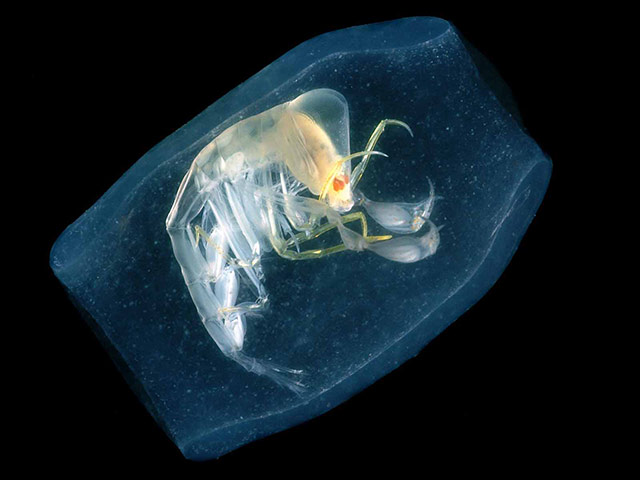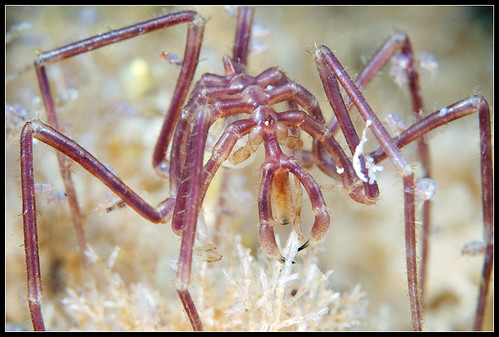Watcher
The Watcher is a poorly known denizen of Europa's sea characterized by an inquisitive (although, luckily, largely passive) behaviour hinting at an higher than average intelligence.Friedrich Nietzsche wrote:[...] when you gaze long into an abyss the abyss also gazes into you.
Watchers are usually found by the crew swimming alongside windows, peering through with an oversized, eerily human eye. They consistently focus on the closest visible active submariner, whether this one is located inside or outside the submarine, and sometime attempt to grasp or poke them with one of their many thin articulated arms (leading them to poke windows when their quarry is inside). Luckily these attempts inflict very little damage, if any to the crew or the submarine, and can easily be discouraged by the slightest damage inflicted on the slowly extending arm. The armoured, bulky body of a Watcher is remarkably resilient to harm, and the creature need to be severely wounded before it decides to flee. Of course, another way to get rid of a Watcher is simply to keep objects of interest out of its sight until it gets bored.
However, this passivity instantly disappears if their eye is targeted. The fragile orb is easily destroyed, and the blind beast then enter a state of mindless fury leading it to attack anything in reach: bashing its head against large objects (such as the submarine) and hysterically flailing its arms -which inflicts continuous damage to fleshy opponents in range. When hurt in this state, the Watcher ram in the direction from which the new wound originates in an attempt at vengeance; without such "input", the Watcher is able to localize and attack the large submarine through its other senses. Due to the aforementioned resilience, Watchers can then inflict sizeable damage to the submarine or the crew before they are stopped, unless one think to target the now bloody eye-socket, which lead to the brain of the creature -while such an assault still can't instantaneously kill the beast due to protective tissues being in place behind the eye, it is a lot faster than to wound the rest of the body, although such a level of precision against a mobile target usually requires divers.
Another way to easily defeat a Watcher is to take advantage of its blindness and simple reaction to attacks: it can be tricked into attacking another wildlife, or be permanently kept between two alternatively shooting divers.
The Watcher is intended to be a low-danger beast mostly intended to convey a mysterious and dreadful atmosphere when you cross its gaze in the darkness, though it can become an additional factor in crisis situation if poorly-handled.
I am not fixed on the intended size: a larger Watcher would be more intimidating and inflict heavier damages on the vessel, but a small one would open the possibility of one entering the gangways in case of breaches and playfully messing with circuits. Perhaps having both would be funny.
Inspirations (may help for appearance design):
- Colossal squids for their eerily human eyes associated with inhuman anatomy and size.
Spoiler
- average octopi for their known intelligence and mischievousness, associated with inhuman anatomy.- cetacean, for their intelligence.
- shrimps, for their many small arms.
I personally envision the Watcher as having the body of a cetacean/shrimp compromise, a large squid eye and a mix of tentacles and articulated arms as... well, arms. As usual, details are in the hands of the team artist.
Harlequins
The various species grouped under the umbrella name "Harlequins" are in league for the title of "less physical impressive animals of Europa". Bar few exceptions, these small bloated creatures are slow, gelatinous and barely cognizant. Of course, there is however a very good reason for the native fauna to avoid hurting them: Harlequins are living biochemical factories with a built-in self-destruct mechanism. Whenever one is mortally wounded, it reflexively pop, shredding its fragile flesh and engulfing its slayer in a cloud of dangerous compound (and making it very difficult for most predator to feed on the resulting gluey mess). Each species presents its own unique brand of chemical post-mortem revenge, and each is characterised by distinctive garish colouration and psychedelic skin patterns on its bulbous hump, allowing beforehand identification of the toxic agent by observant individuals.
Relying exclusively on the consequences of their death as a deterrent, Harlequins are unusually docile, to the point of being easy to pick up and move around by hand: their only reaction is to simulate agony (threatening imminent explosion) by making its hump bloat and pulsate, displaying light signals, and ineffectively flailing its weak limbs. When released, they immediately calm down. Due to this passivity, colonists have taken to capture, sometime breed, Harlequins for easy production of their corresponding chemicals: one just has to correctly identify the breed, corral them to prevent them wandering off, sedate them before "milking", and be careful during the extraction process so as not to "manually" trigger the detonation by accident.
Some examples of Harlequin gland produces:
- toxin: this straightforward substance hurts and repels Europan fauna (though giant monsters are too tough and stubborn to be incapacitated by it alone, obviously). While it hasn't evolved to hurt Earth-based organisms, most humans happen to be violently allergic to it, and are mildly hurt if they cross a cloud of this toxin without protective equipment. Rumour is that syringes of concentrated toxin would be quite the lethal and discreet weapon against colonists, but why would anyone do that?
- lure: using the principle of the biological "burglar alarm", this sticky substance slowly dissolve to release an odour that a lot of large European predators have associated with easy preys. Poor sprayed individuals can expect to be regularly visited by curious monsters for the minutes to come.
- explosive: most Harlequins use a weak detonation to spread around their payload; these species technically don't release any special additional substance, as the explosion provoked by especially volatile chemicals is punishing enough in its own. This variant is often used to make bombs; they can be put somewhere and then shot at a distance to produce the same result, but explosive Harlequins are among the most mobile and are liable to leave their post before one can get at a safe distance for the triggering.
It is important to note that the behavioural notes above applies to "solitary" Harlequins; other varieties are eusocial, like ants, and live in large colonies squeezed in drifting hives made of glued-together debris (such as bones, for example). In this case, various castes have different roles, and the castes tasked with protecting the hive care not about the value of their personal life: these unusually fast and active Harlequins rush down enemies of the hive and actively trigger their explosion in a kamikaze fashion. Approach Harlequin hives with caution.
I personally envision the Harlequins as looking like a cross between a tick and an octopus (for the bloated body aspect), with colour schemes and flesh texture reminiscent of sea slugs. Variants have not only different patterns, but their proportions may also vary, with more mobile species having longer legs for example.







